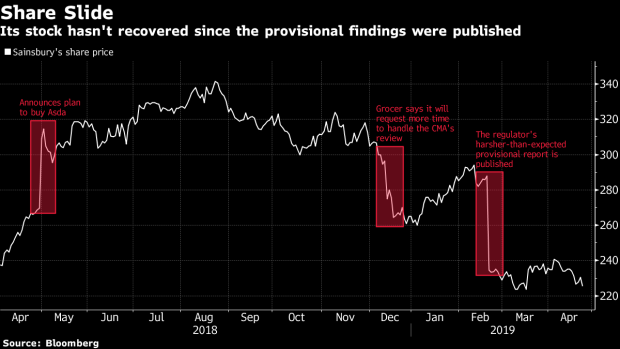Apr 24, 2019
Sainsbury’s Clouded Walmart Deal Has Already Cost It Plenty
, Bloomberg News

(Bloomberg) -- As J Sainsbury Plc awaits antitrust regulators’ final decision on its plan to buy Walmart Inc.’s Asda, the U.K. grocer faces mounting bills, a dwindling market share and a falling stock price.
The companies are set Thursday to learn the fate of the 7.3 billion-pound ($9.4 billion) deal, under which they aim to form the biggest U.K. supermarket owner. It looked close to collapse in February after the Competition and Markets Authority said in a provisional report that even with substantial store sales, the combination would likely mean higher prices and less choice for shoppers.
Since then, Sainsbury’s woes have deepened as the company lost its No. 2 position among U.K. supermarkets to Asda. Its market share has fallen by 0.6 percentage points in the last 12 months, to 15.3 percent, as German discounters Aldi and Lidl have gained ground and larger rival Tesco Plc has used its scale to push down prices.
As it focused on the Asda deal, Sainsbury has trimmed other areas that might have helped it shore up its market share. The grocer last year cut advertising spending by 24 percent, reducing its budget for television commercials by more than half, according to data from Nielsen.
Sainsbury’s holiday sales fell more than analysts expected as the company cited consumer caution amid the political stalemate over Brexit. It will report its full-year earnings next Wednesday, when the full cost of the deal will likely be revealed. As of September, Sainsbury’s had spent 17 million pounds on legal and banking fees, according to its half-year results.
“Sainsbury’s could be in quite considerable trouble if the CMA does not change its mind,” Clive Black, an analyst at Shore Capital, said by phone. “Its business is not trading well, and it leads me to believe that there could be the potential for an earnings downgrade or even an official profit warning in the future.”
Sainsbury shares have taken a pounding this year and haven’t recovered from their biggest fall in a decade when the CMA published its provisional findings. Since the merger was announced, the grocer has fallen 27 percent, wiping nearly 2 billion pounds off its market value.
The shares could fall further if regulators stick to their guns and the grocers abandon the deal, analysts at JPMorgan said in a note. Sainsbury’s earnings may also disappoint investors, they said.
To try to secure regulatory approval for the deal, Sainsbury has pledged 1 billion pounds in price cuts and offered to sell between 125 and 150 stores. But the regulator said in its provisional finding that the merger would hurt competition in 629 local areas where both companies operate.
Sainsbury did not immediately respond to a request for comment. Despite falling behind Asda in overall market share, the company still sells more groceries, but the Kantar figures do not account for Sainsbury’s Argos household-goods business.
Sainsbury’s stores and staff have already felt the impact of cuts. Last year, Sainsbury pushed through a contentious new pay deal for thousands of employees. Amid heavy political criticism, Chief Executive Officer Mike Coupe said that the U.K. sector was undergoing a structural shift -- including the rise of discounters and online shopping -- that necessitated changes in the way it operates.
As part of the new pay plan, Sainsbury’s also removed thousands of management roles in its supermarkets and has since faced criticism for declining store standards, including poor product availability. In November, when the grocer revealed a 40 percent fall in its first-half profit, Coupe blamed disruptions from implementing the compensation system as well as a hot summer for shortages on shelves.
“Given the state of Sainsbury’s stores at the moment, we will need to see some investment going into the business,” and that could cut profit margins, Black said.
--With assistance from Joe Mayes and Jonathan Browning.
To contact the reporters on this story: Ellen Milligan in London at emilligan11@bloomberg.net;Deirdre Hipwell in London at dhipwell@bloomberg.net
To contact the editors responsible for this story: Eric Pfanner at epfanner1@bloomberg.net, Anthony Aarons
©2019 Bloomberg L.P.





